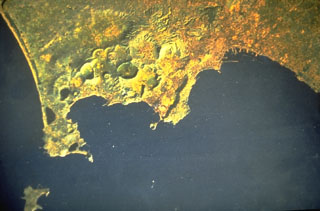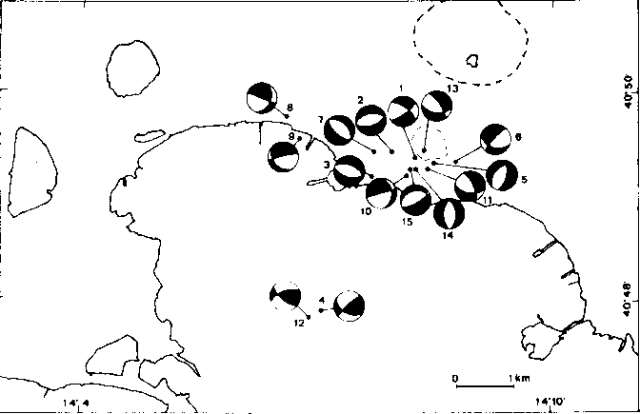Report on Campi Flegrei (Italy) — March 1984
Scientific Event Alert Network Bulletin, vol. 9, no. 3 (March 1984)
Managing Editor: Lindsay McClelland.
Campi Flegrei (Italy) More vigorous seismicity; uplift continues
Please cite this report as:
Global Volcanism Program, 1984. Report on Campi Flegrei (Italy) (McClelland, L., ed.). Scientific Event Alert Network Bulletin, 9:3. Smithsonian Institution. https://doi.org/10.5479/si.GVP.SEAN198403-211010
Campi Flegrei
Italy
40.827°N, 14.139°E; summit elev. 458 m
All times are local (unless otherwise noted)
"The rate of seismic strain energy release at Campi Flegrei was higher during the first three months of 1984 than during 1983. The seismic strain energy released in the first three months of 1984 was almost as high as that released during all of 1983, although it must be noted that seismic activity did not begin to be detected until March 1983. Seasonal trends in periods of quiet activity have been observed at Campi Flegrei. The complex interplay between external and internal causes of the present crisis makes prediction of the development of the phenomenon still more difficult.
"A peak in activity occurred during the second week of March and at the beginning of April 1984. A magnitude 3.9 earthquake occurred 9 March and five days later a M 4.0 earthquake caused the roof collapse of a fifteenth century church in Pozzuoli. No injuries occurred. The close association of these two earthquakes caused some concern about the possible development of the continuing crisis. On 1 April, a seismic swarm of 499 events occurred between 0300 and 0800. The maximum magnitude was 3.0. The preliminary location is in an area about 1 km W of Pozzuoli, the same area as another swarm on 13 October 1983.
"An analysis of the reliability of hypocentral determinations has been performed using different velocity models. The uncertainties in the velocity model prevent any reliable estimate of the true depth of the earthquakes, even if they are definitely confined within the upper 4 km of crust. The effect of different velocity models does not appreciably change the epicentral determinations. The most energetic events are still confined in a small area around Solfatara Crater. The M 4.0 earthquake of 14 March was located ~ 1 km SE of Solfatara.
"The focal mechanisms of 37 selected events have been studied. Fifteen reliable solutions were obtained (figure 4). Ten events, located around Solfatara Crater, are of tensional type. Two events, located in the Gulf of Pozzuoli, seem of compressive type. No predominant orientation of the P and T axes is found.
"The previously inferred trend of high deformation rates preceding the largest shocks was not observed for the last two large events. The velocity of uplift, as measured by the Pozzuoli tide gauge, was in the range of 2-3 mm/day during the first two weeks of March 1984; it increased to ~ 4 mm/day during the last two weeks in March. A survey of the levelling network was completed during March. The pattern of deformation is similar to that observed in December 1983. A maximum uplift of 32 cm since December 1983 was measured near Pozzuoli. The maximum uplift since January 1982 was 142 cm. Geochemical surveillance was implemented in 1983 as a consequence of the uplift. Some variations in the chemical composition of water wells have been detected between January and March 1984. In the same period, small variations in the composition of fumarolic gases from Solfatara Crater have been recorded (slight increase of the S/C ratio). The radon content was approximately constant. The reducing capacity of fumarolic gases has been continuously monitored at two fumaroles within Solfatara Crater, showing a broad peak since mid-February, and reaching a maximum in mid-March.
Geological Summary. Campi Flegrei is a 13-km-wide caldera that encompasses part of Naples and extends to the south beneath the Gulf of Pozzuoli. Episodes of significant uplift and subsidence within the dominantly trachytic caldera have occurred since Roman times. The earliest known eruptive products are dated 47,000 years BP. The caldera formed following two large explosive eruptions, the massive Campanian ignimbrite about 36,000 BP, and the over 40 km3 Neapolitan Yellow Tuff (NYT) about 15,000 BP. Following eruption of the NYT a large number of eruptions originated from widely scattered subaerial and submarine vents. Most activity occurred during three intervals: 15,000-9,500, 8,600-8,200, and 4,800-3,800 BP. The latest eruption were in 1158 CE at Solfatara and activity in 1538 CE that formed the Monte Nuovo cinder cone.
Information Contacts: G. Luongo and R. Scandone, OV; F. Barberi, Univ. di Pisa; M. Carapezza, Univ. di Palermo.


